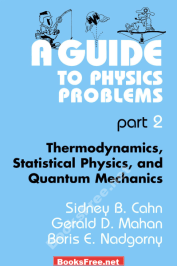| Book Name: | A Guide to Physics Problems Part 2 |
| Free Download: | Available |

| Guide Particulars : | |
|---|---|
| Language | English |
| Pages | 374 |
| Format | |
| Measurement | 5.71 MB |
A Guide to Physics Problems Part 2
A Guide to Physics Problems Contents
Thermodynamics and Statistical Physics
- Introductory Thermodynamics
- Warmth and Work
- Nonideal Gasoline
- Mixtures and Part Separation
- Quantum Statistics
- Fluctuations
- Purposes to Stable State
Quantum Mechanics
- One-Dimensional Potentials
- Harmonic Oscillator
- Angular Momentum and Spin
- Variational Calculations
- Perturbation Principle
- WKB
- Scattering Principle
- Basic
Preface to A Guide to Physics Problems
Part 2 of A Guide to Physics Problems comprises issues from written graduate qualifying examinations at many universities in america and, for comparability, issues from the Moscow Institute of Physics and Know-how, a number one Russian Physics Division.
Whereas Part 1 offered issues and options in Mechanics, Relativity, and Electrodynamics, Part 2 affords issues and options in Thermodynamics, Statistical Physics, and Quantum Mechanics.
The primary objective of the ebook is to assist graduate college students put together for this essential and infrequently very traumatic examination (see Determine P.1). The issue and scope of the qualifying examination range from college to college, however not too dramatically.
Our objective was to current a roughly common set of issues that may enable college students to really feel assured at these exams, whatever the graduate college they attended.
We additionally thought that physics majors who’re contemplating happening to graduate college could give you the chance to take a look at their data of physics by making an attempt to clear up a number of the issues, most of which aren’t above the undergraduate degree.
As in Part 1, now we have tried to present as many particulars in our options as doable, with out turning to a commerce expression of an exhausted creator who, after scuffling with the derivation for a few hours writes, “As it may be simply proven….”
Many of the feedback to Part 1 that now we have obtained up to now have come not from the scholars however from the professors who’ve to give the exams.
The commonest remark was, “Gee, nice, now I can use one among your issues for our subsequent complete examination.”
Nevertheless, we nonetheless hope that this doesn’t make the ebook counterproductive and ultimately it should assist the scholars to remodel from the state proven in Determine P.1 into a way more snug stationary state as in Determine P.2.
This image will be simply attributed to the current mind-set of the authors as effectively, who sincerely hope that Part 3 won’t be forthcoming any time quickly.
A number of the faculties wouldn’t have written qualifying exams as a part of their necessities: Brown, Cal-Tech, Cornell, Harvard, UT Austin, College of Toronto, and Yale.
Many of the faculties that give such an examination had been blissful to belief us with their issues. We want to thank the Physics Departments of Boston College (Boston), the College of Colorado at Boulder (Colorado), Columbia College (Columbia), College of Maryland (Mary- land)
Massachusetts Institute of Know-how (MIT), College of Michi- gan (Michigan), Michigan State College (Michigan State), Michigan Technological College (Michigan Tech), Princeton College (Princeton), Rutgers College (Rutgers), Stanford College (Stanford), the State College of New York at Stony Brook (Stony Brook), the College of Tennessee at Knoxville (Tennessee)
And the College of Wisconsin (Wisconsin-Madison). The Moscow Institute of Physics and Know-how (Moscow Phys-Tech) doesn’t give any such qualifying examination in graduate college.
A few of their issues got here from the ultimate written examination for the physics seniors, a number of the others, largely introductory issues, are from their oral entrance exams or magazines reminiscent of Kvant.
A few of the issues had been compiled by the authors and have by no means been printed earlier than. We had been blissful to hear many encouraging feedback about Part 1 from our colleagues, and we’re grateful to all people who took their time to evaluate the ebook.
We want to thank many individuals who contributed a number of the issues to Part 2 or mentioned options with us, specifically Dmitri Averin (Stony Brook), Michael Bershadsky (Harvard), Alexander Korotkov (Stony Brook), Henry Silsbee (Stony Brook), and Alexei Stuchebrukhov (UC Davis).
We thank Kirk McDonald (Princeton) and Liang Chen (British Columbia) for his or her useful feedback to some issues in Part 1; we hope to embody them within the second version of Part 1, popping out subsequent 12 months.
We’re indebted to Max Dresden for writing the Foreword, to Tilo Wettig (Münich) who learn most, of the manuscript, and to Vladimir Gitt and Yair Minsky who drew the humorous footage.
Download A Guide to Physics Problems Part 2 in PDF Format For Free.
Related More Books
See More POST On : Mechanical Books



